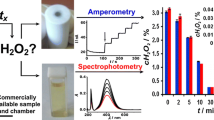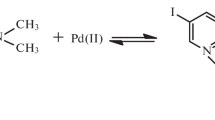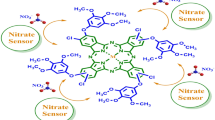Abstract
In this work, the PhotoThermal Lens (PTL) spectrometry was used to investigate the contamination effect of the quartz cuvette on the quantification of permanganate concentration in tap water at neutral pH. Different permanganate solutions were prepared at a concentration range from 0.2 µM to 10 µM. The PTL signal measurements for samples with the same permanganate concentration in tap water increase continuously. The PTL signals for samples with the same permanganate concentration in tap water showed a significant increase between two successive measurements. Contrary to the solutions prepared in distilled water where the PTL signal remains constant for all the measurements. Thus, it results from that the main cause of this behavior is related to the decomposition reaction of permanganate in tap water giving rise to manganese dioxide, which then will be adsorbed on the optical window surfaces of the quartz cuvette. The contribution of the adsorbed amount on the PTL signal was examined and its variation was described based on the Langmuir model. To remove this contamination effect caused by the adsorption process, three 0.1 M acidic solutions (HCl, H2SO4 and H3PO4) were applied separately for the cleaning of the optical window surfaces. The obtained results show that 4 min is sufficient to reach a desorption rate higher than 90% whatever the used acid.






Similar content being viewed by others
References
W. Yu, L. Campos, T. Shi, G. Li, N. Graham, RSC Adv. Adv. 5, 27970–27977 (2015). https://doi.org/10.1039/c5ra01643f
A.I. Omoike, D. Harmon, Chemosphere 223, 391–398 (2019). https://doi.org/10.1016/j.chemosphere.2019.02.036
L. Hu, A.M. Stemig, K.H. Wammer, T.J. Strathmann, Environ. Sci. Technol. 45, 3635–3642 (2011). https://doi.org/10.1021/es104234m
J. Jiang, Y. Gao, S.Y. Pang, Q. Wang, X. Huangfu, Y. Liu, J. Ma, Environ. Sci. Technol. 48, 10850–10858 (2014). https://doi.org/10.1021/es5008577
R.B. Geerdink, R. Van Den Sebastiaan Hurk, O.J. Epema, Anal. Chim. Acta 961, 111 (2017). https://doi.org/10.1016/j.aca.2017.01.009
A. Sinha Dhanjai, H. Zhao, J. Chen, S.M. Mugo, Encycloped Anal Sci. (2019). https://doi.org/10.1016/B978-0-12-409547-2.14517-2
United State Environmental Protection Agency (USEPA): Edition of the Drinking Water Standards and Health Advisories, https://www.epa.gov/system/files/documents/2022-01/dwtable2018.pdf
State Environmental Protection Administration (SEPA): Environmental Quality Standard for Surface Water (GB 3838–2002) (Standards Press, Beijing, 2002), p. 4e6, https://www.mee.gov.cn/ywgz/fgbz/bz/bzwb/shjbh/shjzlbz/200206/W020061027509896672057.pdf (in Chinese)
World Health Organization (WHO): Guidelines for Drinking Water Quality, 4th edn. (2011), https://iris.who.int/bitstream/handle/10665/44584/9789241548151_eng.pdf?sequence=1
Z.S. Yan, B. Liu, F.S. Qu, A. Ding, H. Liang, Y. Zhao, G.B. Li, Sep. Purif. Technol.Purif. Technol. 172, 51–58 (2017). https://doi.org/10.1016/j.seppur.2016.07.0549
X. Liu, H. Cai, J. Zou, Z. Pang, B. Yuan, Z. Zhou, Q. Cheng, Chemosphere 212, 604–610 (2018). https://doi.org/10.1016/j.chemosphere.2018.08.087
S.T. McBeath, D.P. Wilkinson, N.J.D. Graham, Chemosphere 251, 126626 (2020). https://doi.org/10.1016/j.chemosphere.2020.126626
Z. Pang, Y. Cai, W. Xiong, J. Xiao, J. Zou, Chemosphere 266, 128936 (2021). https://doi.org/10.1016/j.chemosphere.2020.128936
L. Hao, Y. Qi, Y. Wu, D. Xia, Heliyon. 9, e13587 (2023). https://doi.org/10.1016/j.heliyon.2023.e13587
R. Hannachi, Sens Actuators B Chem. 333, 129542 (2021). https://doi.org/10.1016/j.snb.2021.129542
J.R. Laszakovits, A. Patterson, C. Hipsher, A.A. MacKay, Water Res. 151, 403–412 (2019). https://doi.org/10.1016/j.watres.2018.12.031
Z. Kang, Z. He, Y. Wen, M. Liao, X. Li, H. Chen, Q. Zhang, Measurement 187, 110125 (2022). https://doi.org/10.1016/j.measurement.2021.110125
S.E. Bialkowski, N.G.C. Astrath, M.A. Proskurnin, Photothermal spectroscopy methods (Wiley, Hoboken. p, 2019), p.512
J. Zhou, S. Xu, J. Liu, Nanomaterials 12, 1884 (2022). https://doi.org/10.3390/nano12111884
M. Franko, L. Goljat, M. Liu, H. Budasheva, M. Žorž Furlan, D. Korte, Sensors. 23, 472 (2023). https://doi.org/10.3390/s23010472
I. Soyeh, R. Hannachi, H. Sammouda, L. Béji, Appl. Phys. B 128(9), 174 (2022). https://doi.org/10.1007/s00340-022-07894-9
F. Freeman, C.O. Fuselier, C.R. Armstead, C.E. Dalton, P.A. Davidson, E.M. Karchefski, D.E. Krochman, M.N. Johnson, N.K. Jones, J. Am. Chem. Soc. 103, 1154–1159 (1981). https://doi.org/10.1021/ja00395a026
F. Mata-Perez, J.F. Perez-Benito, Can. J. Chem. 63, 988 (1985). https://doi.org/10.1139/v85-165
M. Dose Wesley, W. Donne Scott, J. Appl. Cryst. 46, 1283–1288 (2013). https://doi.org/10.1107/S0021889813017846
J. Shen, R.D. Lowe, R.D. Snook, Chem. Phys. 165, 385–396 (1992). https://doi.org/10.1016/0301-0104(92)87053-C
A. Marcano, H. Cabrera, M. Guerra, R.A. Cruz, C. Jacinto, T. Catunda, J. Opt. Soc. Am. B 23(7), 1408–1413 (2006). https://doi.org/10.1364/JOSAB.23.001408
G. Kim, D. Kim, S. Kang, J. Yoo, H. Kim, Appl. Sci. 11, 1535 (2021). https://doi.org/10.3390/app11041535
M.Y. Kononets, M.A. Proskurnin, S.N. Bendrysheva, V.V. Chernysh, Talanta 53, 1221–1227 (2001). https://doi.org/10.1016/S0039-9140(00)00613-5
D.A. Nedosekin, A.V. Pirogov, W. Faubel, U. Pyell, M.A. Proskurnin, Talanta 68, 1474–1481 (2006). https://doi.org/10.1016/j.talanta.2005.08.010
D.A. Nedosekina, E.V. Ageevab, I.V. Mikheevc, D.S. Volkovc, M.A. Proskurnin, J. Anal. Chem. 73(6), 526–532 (2018). https://doi.org/10.1134/S1061934818060102
Author information
Authors and Affiliations
Contributions
Ilhem Soyeh prepared the experimental results Riadh Hannachi wrote the manuscrit and revised the figures Habib Sammouda revised the manuscript
Corresponding author
Ethics declarations
Competing interests
The authors declare no competing interests.
Additional information
Publisher's Note
Springer Nature remains neutral with regard to jurisdictional claims in published maps and institutional affiliations.
Rights and permissions
Springer Nature or its licensor (e.g. a society or other partner) holds exclusive rights to this article under a publishing agreement with the author(s) or other rightsholder(s); author self-archiving of the accepted manuscript version of this article is solely governed by the terms of such publishing agreement and applicable law.
About this article
Cite this article
Soyeh, I., Hannachi, R. & Sammouda, H. Investigation of the quartz cuvette surface contamination used for permanganate quantification in tap water by photothermal lens spectrometry. Appl. Phys. B 130, 15 (2024). https://doi.org/10.1007/s00340-023-08149-x
Received:
Accepted:
Published:
DOI: https://doi.org/10.1007/s00340-023-08149-x




